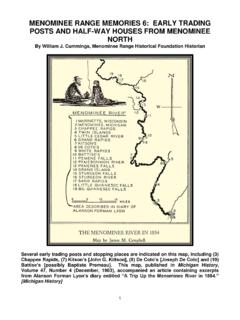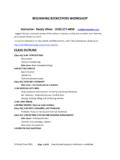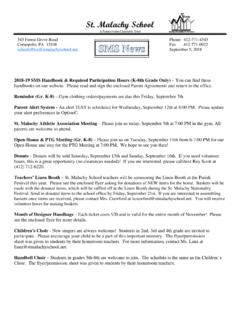Transcription of WHEELS – The Horse and Buggy Era
1 PRESENTS WHEELS The Horse and Buggy Era Part 1 Researched and Compiled by William J. Cummings 2013 The Gold State Coach is an enclosed, eight Horse -drawn carriage used by the British Royal Family. It was built in the London workshops of Samuel Butler in 1762 and has been used at the coronation of every British monarch since George IV. The coach's great age, weight, and lack of maneuverability have limited its use to grand state occasions such as coronations, royal weddings, and the jubilee(s) of a monarch. THE BRITISH ROYAL FAMILY S GOLD STATE COACH 1762 The coach weighs four tons and is 24 feet long and 12 feet high. It is gilded and features painted panels by Giovanni Cipriani and rich gilded sculpture including three cherubs on the roof (representing England, Ireland and Scotland) and four tritons, one at each corner (representing Britain's imperial power).
2 The body of the coach is slung by braces covered with Morocco leather and decorated with gilt buckles. The interior is lined with velvet and satin. The Gold State Coach is pulled by a team of eight horses wearing the Red Morocco harness. Originally driven by a coachman, the horses are now postilion-ridden in pairs. The coach is housed at the Royal Mews of Buckingham Palace. THE BRITISH ROYAL FAMILY S GOLD STATE COACH 1762 King Edward VII, son of Queen Victoria, and his wife, Queen Alexandra, rode in the Gold State Coach on their coronation day, August 9, 1902. Pulled by a hitch of eight matched horses , postilion-ridden in pairs, the procession wended its way through London amid the pomp and circumstance typical of such occasions. [WJC Photo] THE BRITISH ROYAL FAMILY S GOLD STATE COACH 1762 King Edward VII, son of Queen Victoria, and his wife, Queen Alexandra, rode in the Gold State Coach on their coronation day, August 9, 1902.
3 Pulled by a hitch of eight matched horses , postilion-ridden in pairs, the procession wended its way through London amid the pomp and circumstance typical of such occasions. Here the coach is approaching Westminster Abbey. [WJC Photo] THE BRITISH ROYAL FAMILY S GOLD STATE COACH 1762 King Edward VII, son of Queen Victoria, and his wife, Queen Alexandra, rode in the Gold State Coach on their coronation day, August 9, 1902. Pulled by a hitch of eight matched horses , postilion-ridden in pairs, the procession wended its way through London amid the pomp and circumstance typical of such occasions. Here the coach is passing down Whitehall en route to Westminster Abbey. [WJC Photo] THE BRITISH ROYAL FAMILY S GOLD STATE COACH 1762 King Edward VII, son of Queen Victoria, and his wife, Queen Alexandra, posed in their coronation robes at the King s entrance in the Court of Buckingham Palace on their coronation day, August 9, 1902, upon their return from Westminster Abbey.
4 The King wore the official crown of England, known as St. Edward s Crown, made for King Charles II in 1660 at the time of the British Monarchy s Restoration. [WJC Photo] THE BRITISH ROYAL FAMILY S GOLD STATE COACH 1762 London Bridge was decked out for the Coronation of King Edward VII on August 9, 1902. Note the heavy traffic of Horse -drawn conveyances crossing the Thames River. [WJC Photo] LONDON BRIDGE IN CORONATION DRESS 1902 This 1896 stereoview of London s Fleet Street, the heart of the city s business district, appears crowded with a variety of carriages and wagons, and an open-topped, Horse -drawn omnibus can be seen in the foreground. [WJC Photo] Horse AND Buggy ERA LONDON Open-topped Horse -drawn omnibuses, carriages and wagons crowd London s Trafalgar Square, looking toward the Strand, in about 1909.
5 [WJC Photo] Horse AND Buggy ERA LONDON Dating from the 1860 s, this view of Boston s Quincy Market and Faneuil Hall shows all kinds of Horse -drawn wagons lined up on market day. Note that some of the wagons are covered, like the Conestoga wagons made famous in pioneer times. [WJC Photo] Horse AND Buggy ERA BOSTON QUINCY MARKET These street peddlers carts lined Elizabeth Street, looking north from Hester Street in New York City, in about 1904. This was a part of the city s slum district. There were shops and stores in all these ground-floor rooms and basements, and in every room from cellars to roofs people lived, crowded into dirty and ill-smelling tenements. Italians populated a good part of this particular street, but Hebrews and others of all sorts and kinds also made homes here.
6 [WJC Photo] Horse AND Buggy ERA NEW YORK ELIZABETH ST. This 1890 s view shows some of the 100 block of West Street, New York City. Businesses able to be identified on this photograph included: 172, Consolidated Refrigeration; 173, Meacham & Farnham Fruits; 174, J. Romer & Co. Flour and Seed; 175, William Dinwoodie Imported Brandies Wine and Dinwoodie s Hotel. Another sign on side of building on next block reads Bogardus & Ellary Hardware, Agricultural Implements, Home Furnishing Goods, Ice, Tools and another, partially visible, reads Duryea s Son underneath the hardware sign. A multitude of Horse -drawn delivery carts are jammed in the street, including a trolley. [WJC Photo] Horse AND Buggy ERA NEW YORK CITY WEST ST. This early 1900 s view of Randolph Street east from LaSalle Street in Chicago shows a line of hacks at the right, two wagons going down the street and three trolley cars at the left.
7 Note the stand in the lower right corner. [WJC Photo] Horse AND Buggy ERA CHICAGO RANDOLF STREET This 1893 view of Chicago s State Street showed the trolley tracks, as well as elegant carriages, hacks and wagons delivering merchandise. Pedestrians filled the streets, busy shopping along this famed street. [WJC Photo] Horse AND Buggy ERA CHICAGO STATE STREET Heavy traffic on Chicago s State Street in 1898 was an indicator of how important this shopping district was at the time. Note the two wagons loaded with barrels and the trolleys making their way through the crowded thoroughfare. [WJC Photo] Horse AND Buggy ERA CHICAGO STATE STREET In this 1890 s view of State Street, Chicago, pedestrians fill the sidewalk, some inspecting the bananas for sale at the side of the street.
8 Open rental hacks, wagons and trolleys provide transportation along this busy thoroughfare, the heart of Chicago s shopping district. [WJC Photo] Horse AND Buggy ERA CHICAGO STATE STREET This view of Chicago s State Street, looking north from Adams Street, shows the immense volume of business conducted here. Peacock s was a well-known jeweler s shop. Berry s, on the west side of the street, was a popular restaurant and candy shop. The large white building farther north on the west side was The Fair, a famous department store. [WJC Photo] Horse AND Buggy ERA CHICAGO STATE STREET Chicago s State Street, looking north from Madison Avenue, shows the Masonic Temple at the end of the street in this 1902 stereoview. Pedestrians crowd the west side of the street, and a line of Horse -drawn hacks await passengers at the curbside.
9 The busy street shows a variety of Horse -drawn vehicles, as well as trolleycars, traveling on the tracks down the center of the thoroughfare. [WJC Photo] Horse AND Buggy ERA CHICAGO STATE STREET Chicago s State Street, looking north from Madison Avenue, shows the Masonic Temple in distance in this 1905 stereoview. [WJC Photo] Horse AND Buggy ERA CHICAGO STATE STREET This 1892 view of South Water Street, Chicago, shows many wagons bringing and picking up produce from the city s center for produce and vegetables. In 1925 the South Water Street Market was built. The modern market covered eight square blocks, bounded by Racine Avenue on the west, Morgan Street on the east, 14th Street on the north and the Baltimore and Ohio Railroad on the south. The streets were made 100 feet wide and the alleys 42 feet.
10 [WJC Photo] Horse AND Buggy ERA CHICAGO SOUTH WATER ST. This view of San Francisco s famed Market Street, was taken in 1901, five years before the 1906 earthquake which virtually destroyed the California city. Today Market Street is the boundary of two street grids. Streets on its southeast side are parallel or perpendicular to Market Street, while those on the northwest are nine degrees off from the cardinal directions. [WJC Photo] Horse AND Buggy ERA SAN FRANCISCO This view of Broadway, taken looking north from Chestnut in St. Louis, showed one of the most important streets in the city s business district, and was taken at about the time of the St. Louis World s Fair in 1904. [WJC Photo] Horse AND Buggy ERA ST. LOUIS BROADWAY The camera is facing north on Stephenson Avenue in the mid-1880 s in this view of the east side of the 200 block where the First National Bank is now located.








